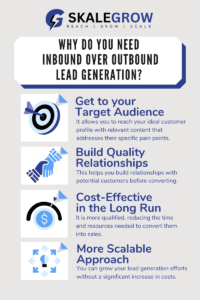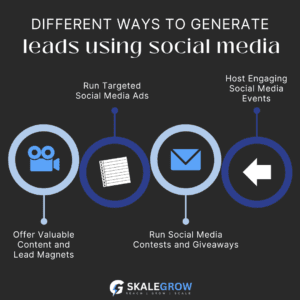We all know that qualified leads are the lifeblood of any successful business. Generating these leads can feel like a constant uphill battle. Traditional outbound marketing tactics, like cold calling, often have limitations. They can be time consuming, have limited reach, and struggle to capture genuine interest from potential customers who are bombarded with marketing messages every day.
This is where inbound marketing shines. B2B inbound marketing flips the script. Instead of chasing leads, it creates an online environment that draws potential customers in. It’s about attracting the right audience with valuable content, building trust and interest in your solutions. Here’s the key: inbound marketing targets those already actively seeking information about your industry or solutions you offer. This targeted approach yields higher engagement and increases the likelihood of converting leads into paying customers.
The benefits of inbound marketing for B2B lead generation are numerous. Inbound marketing allows you to establish thought leadership while attracting qualified leads. It supports deeper engagement with potential customers. While traditional outbound marketing can be expensive, inbound marketing strategies offer long-term value and cost-effectiveness as you nurture leads through the sales funnel.

But how do you put a winning inbound marketing strategy into action? This blog explores five powerful inbound marketing strategies specifically designed for B2B lead generation, helping you attract high-converting leads who are ready to engage with your brand.
1. Content Marketing: The Cornerstone of Inbound Strategy
Content marketing is the foundation of any successful inbound strategy. By creating informative, engaging content that addresses your target audience’s pain points and interests, you establish yourself as a thought leader in your industry. What you need the most is a good B2B content marketing funnel which will position your brand as a trusted resource, attracting qualified leads who are actively seeking solutions.
Here’s how to utilize content marketing effectively for B2B lead generation:
- Content Variety: Go beyond blog posts! Create a diverse content marketing plan with formats like white papers, eBooks, case studies, industry reports, infographics, and even video content. This caters to different learning styles and preferences within your audience.
- Quality Over Quantity: Focus on creating high-quality content that is well-researched, informative, and engaging. Optimize your content for readability and scanability.
- Target Audience Focus: Tailor your content to the specific needs and challenges faced by your ideal customer. This demonstrates a deep understanding of their pain points and positions you as the solution provider.
- SEO Optimization: Integrate relevant keywords naturally throughout your content marketing plan to improve search engine ranking. This increases the chances of your content appearing in search results when your target audience is looking for information related to your offerings.
- Content Promotion: Don’t just publish and pray! Promote your content across various channels like social media, email marketing, and industry publications. Leverage paid advertising platforms to target specific demographics with high-performing content.
2. SEO Optimization: The Power of Organic Visibility
Search engine optimization (SEO) plays a crucial role in driving qualified traffic to your website. By optimizing your website and content for relevant keywords, you improve your organic search ranking, making it easier for potential customers to find you when they search online. Here’s how you can get started with SEO in 3 days.
Here are some key aspects of SEO to prioritize for B2B lead generation:
- Keyword Research and Identification: Thoroughly research keywords related to your industry, products, and services. Focus on keywords with high to medium search volume and low to medium competition or keyword difficulty.
- On-Page Optimization: Optimize your website pages for relevant keywords by strategically incorporating them into page titles, meta descriptions, headings, and throughout the content. Ensure your website is mobile-friendly, loads quickly, and has a clear and intuitive navigation structure.
- Off-Page Optimization: Build high-quality backlinks to your website from reputable industry websites and publications. This signals trust and authority to search engines, ultimately boosting your website’s ranking. SERP includes such unpaid listings that the search engine deems most relevant to your query.
3. Social Media Marketing: Building Relationships and Engagement
Social media platforms offer a powerful avenue for connecting with your target audience, fostering brand awareness, building relationships, and ultimately generating leads. However, a generic approach won’t cut it in B2B marketing.
Here’s how to leverage social media effectively for B2B lead generation:

Different ways to generate leads using social media
- Identify Relevant Platforms: Research where your target audience spends their time online and focus your efforts on those specific social media platforms. For example, LinkedIn is one of the best platforms for B2B businesses to find their target audiences on.
- Valuable Content is Key: Don’t just post promotional content as a social media marketing strategy. Share valuable insights, industry news, thought leadership pieces, and engaging content that resonates with your audience’s interests.
- Targeted Social Media Advertising: Utilize social media advertising platforms to target specific demographics, interests, and job titles. This allows you to tailor your messaging directly to your ideal customer profile in your social media marketing plan.
- Social Listening and Community Building: Actively listen to industry conversations on social media platforms. Make use of tools such as Brandwatch, Brands24, etc. Respond to comments and participate in discussions relevant to your niche. This establishes your brand as a thought leader and helps build a loyal following.
Also read: Top B2B social media marketing trends for 2024 and beyond
4. Email Marketing: Nurturing Leads and Driving Conversions
Email Marketing has taken the world of outreach to a level up! It is a must when it comes to reaching out to potential clients. One can save time and resources, making the part efficient.
- Email Segmentation: Segment your email marketing campaign list based on demographics, interests, and stages in the buying journey. This allows you to deliver personalized content that resonates with each recipient’s specific needs.
- Lead Nurturing Sequences: Develop automated marketing email sequences designed to nurture leads at various stages of the buying journey. These sequences can provide educational content, address specific pain points, offer case studies, and guide leads towards becoming paying customers.
- Track Email Marketing Metrics: Monitor key email marketing metrics like open rates, click-through rates, and conversion rates. Analyze this data to understand what resonates with your audience and continuously refine your email marketing strategies for better performance.
Also read: 5 B2B Email Marketing Hacks You Should Try In 2024
5. Conversational Marketing: Personalization and Real-Time Engagement
Conversational marketing allows you to engage with potential customers in real-time using tools like live chat and chatbots. One of the many benefits of conversational marketing is that it provides a personalized experience for leads, building trust and building relationships throughout the buying journey.
Here’s how conversational marketing can enhance B2B lead generation:
- Personalization at its Finest: For a conversational approach, use chatbots and live chat features to personalize the customer experience by offering immediate support and answering questions in real-time. This builds rapport and demonstrates a commitment to customer satisfaction.
- Lead Qualification and Routing: Chatbots can be programmed to qualify leads based on their questions and interests. This allows you to prioritize leads with high potential and route them to the appropriate sales representatives for further interaction.
- Nurturing Leads Through Conversation: Utilize chat tools like Drift, Intercom, LivePerson, etc., to provide valuable information, this will address specific concerns, and guide leads further down the sales funnel through personalized and engaging conversations.
Conclusion
By leveraging these five powerful inbound marketing strategies, B2B companies can attract qualified leads who are actively seeking solutions. By focusing on creating valuable content, optimizing for search engines, engaging on social media platforms, nurturing leads through email, and providing real-time support with conversational marketing, you can establish a robust online presence that attracts high-converting leads and fuels sustainable growth for your business.
Ready to take your B2B lead generation to the next level? Subscribe to our newsletter to receive 1 B2B growth hack in your inbox every week.
Skalegrow – B2B content marketing agency
With marketing getting tougher and tougher, every wrong foot you make might hamper your growth. What you need is the right guidance and a helping hand. This is where Skalegrow can make a sea of difference.
Skalegrow helps IT, tech, SaaS, robotics, and embedded systems companies leverage new-age marketing tactics to grow their business. From creating an end-to-end content distribution strategy to building a customer-focused content repository, we can help you with everything content. Write to us today at info@skalegrow.com or contact us here to learn how we can generate more demand for your solutions using content.
Check out the below intro video to learn more about what Skalegrow brings to the table:


